Corrosion Activity of Carbon Steel B450C and Low Chromium Ferritic Stainless Steel 430 in Chloride-Containing Cement Extract Solution
Abstract
:1. Introduction
2. Materials and Methods
2.1. Samples and Solution Preparation
2.2. Immersion Test and Surface Characterization
2.3. Electrochemical Measurements
3. Results and Discussion
3.1. Change in Time of pH of Chloride-Containing Cement Extract Solution during Exposure of Steels
3.2. Change in Time of Corrosion Potential (OCP) during Exposure of Steels to Chloride-Containing Cement Extract Solution
3.3. Steel Surface Characterization of Carbon Steel B450C after Exposure to Chloride Containing Cement Extract Solution
3.4. Steel Surface Characterization of SS 430 after Exposure to Chloride-Containing Cement Extract Solution
3.5. Steel Surface Characterization Damage after Exposure to Chloride-Containing Cement Extract Solution
3.6. X-ray Photoelectron Spectroscopy (XPS) Spectra
3.7. Electrochemical Measurements
3.7.1. Potentiodynamic Polarization Curves (PDP)
3.7.2. Electrochemical Impedance Spectroscopy (EIS)
4. Conclusions
Author Contributions
Funding
Data Availability Statement
Acknowledgments
Conflicts of Interest
References
- Pourbaix, M. Atlas of Electrochemical Equilibria in Aqueous Solutions, 2nd ed.; NACE: Houston, TX, USA, 1974; pp. 307–321. [Google Scholar]
- Page, C.L.; Treadaway, K.W.J. Aspects of the electrochemistry of steel in concrete. Nature 1982, 297, 109–115. [Google Scholar] [CrossRef]
- Nóvoa, X.R. Electrochemical aspects of the steel-concrete system. A review. J. Solid State Electrochem. 2016, 20, 2113–2125. Available online: https://link.springer.com/article/10.1007/s10008-016-3238-z (accessed on 2 December 2021). [CrossRef]
- Sedriks, A.J. Corrosion of stainless steels. In Encyclopedia of Materials: Science and Technology, 2nd ed.; Jürgen, B., Flemings, M., Kramer, E., Veyssière, P., Cahn, R., Ilschner, B., Mahajna, S., Eds.; Elsevier: Amsterdam, The Netherlands, 2001; pp. 1707–1708. [Google Scholar] [CrossRef]
- Aguirre, A.M.; Mejía, R. Durability of reinforced concrete exposed to aggressive conditions. Mater. Constr. 2013, 63, 7–38. [Google Scholar] [CrossRef] [Green Version]
- Callaghan, B.G. The performance of a 12% chromium steel in concrete in severe marine environments. Corros. Sci. 1993, 35, 1535–1541. [Google Scholar] [CrossRef]
- Abbott, C.J. Corrosion-free concrete structures with stainless steel. Concrete 1997, 31, 28–32. [Google Scholar]
- Glass, G.K.; Buenfeld, N.R. Chloride-induced corrosion of steel. Prog. Struc. Eng. Mater. 2000, 2, 448–458. [Google Scholar] [CrossRef]
- Shi, X.; Xie, N.; Fortune, K.; Gong, J. Durability of steel reinforced concrete in chloride environments: An overview. Constr. Build. Mater. 2012, 30, 125–138. [Google Scholar] [CrossRef]
- Bertolini, L.; Elsener, B.; Pedeferri, P.; Redaelli, E.; Polder, R. Corrosion of Steel in Concrete: Prevention, Diagnosis, Repair, 2nd ed.; Wiley-VCH Verlag GmbH & Co. KGaA: Weinheim, Germany, 2013; pp. 263–283. [Google Scholar]
- Freire, L.; Carmezim, M.J.; Ferreira, M.G.S.; Montemor, M.F. The passive behaviour of AISI 316 in alkaline media and the effect of pH: A combined electrochemical and analytical study. Electrochim. Acta 2010, 21, 6174–6181. [Google Scholar] [CrossRef]
- Alonso, C.; Castellote, M.; Andrade, C. Chloride threshold dependence of pitting potential of reinforcements. Electrochim. Acta 2002, 47, 3469–3481. [Google Scholar] [CrossRef]
- Hurley, M.F.; Scully, J.R. Threshold Chloride Concentrations of Selected Corrosion-Resistant Rebar Materials Compared to Carbon Steel. Corros. Sci. 2006, 72, 892–904. [Google Scholar] [CrossRef]
- Jaffer, S.J.; Hansson, C.M. Chloride-induced corrosion products of steel in cracked-concrete subjected to different loading conditions. Cem. Concr. Res. 2009, 39, 116–125. [Google Scholar] [CrossRef]
- Marcotte, T.D. Characterization of Chloride-Induced Corrosion Products that form in Steel-Reinforced Cementitious Materials. Ph.D. Thesis, University of Waterloo, Waterloo, ON, Canada, 2001. [Google Scholar]
- Szklarska-Smialowska, Z. Mechanism of pit nucleation by electrical breakdown of the passive film. Corros. Sci. 2002, 44, 1143–1149. [Google Scholar] [CrossRef]
- Miyata, Y.; Asakura, S. Oxygen reduction reaction at rus free iron Surface in neutral unbuffered chloride solutions. Corros. Sci. 2002, 44, 589–602. [Google Scholar] [CrossRef]
- Dawson, J.L.; Langford, P.E. In the Use of Synthetic Environments for Corrosion Testing, ASTM STP; Francis, P.E., Lee, T.S., Eds.; ASTM: Philadelphia, PA, USA, 1988; Volume 970, p. 264. [Google Scholar]
- Berke, N.S.; Hicks, M.C. Corrosion Testing and Evaluation, ASTM STP; Baboian, R., Dean, S.W., Eds.; ASTM: Philadelphia, PA, USA, 1990; Volume 1000, p. 425. [Google Scholar]
- Duffó, G.S.; Farina, S.B. Electrochemical behaviour of steel in mortar and in simulated pore solutions: Analogies and differences. Cem. Concr. Res. 2016, 88, 211–216. [Google Scholar] [CrossRef]
- Poursaee, A.; Hansson, C.M. Potential pitfalls in assessing chloride-induced corrosion of steel in concrete. Cem. Concr. Res. 2009, 39, 391–400. [Google Scholar] [CrossRef]
- Chakri, S.; Frateur, I.; Orazem, M.E.; Sutter, E.M.M.; Tran, T.T.M.; Tribollet, B.; Vivier, V. Improved EIS analysis of the electrochemical behaviour of carbon steel in alkaline solution. Electrochim. Acta 2017, 246, 924–930. [Google Scholar] [CrossRef]
- Ghods, P.; Isgor, O.B.; McRae, G.A.; Gu, G.P. Electrochemical investigation of chloride-induced depassivation of black steel rebar under simulated service conditions. Corros. Sci. 2010, 52, 1649–1659. [Google Scholar] [CrossRef]
- Gunay, H.B.; Isgor, O.B.; Ghods, P. Kinetics of passivation and chloride-induced depassivation of iron in simulated concrete pore solutions using electrochemical quartz crystal nanobalance. Corrosion 2015, 71, 615–627. [Google Scholar] [CrossRef]
- Hussain, R.R.; Alhozaimy, A.; Al-Negheimish, A.; Singh, D.D.N. Time-dependent variation of the electrochemical impedance for thermo-mechanically treated versus plain low alloy steel rebars in contact with simulated concrete pore solution. Constr. Build. Mater. 2014, 73, 283–288. [Google Scholar] [CrossRef]
- Li, L.; Sagüés, A.A. Chloride corrosion threshold of reinforcing steel in alkaline solutions—Open-circuit immersion tests. Corrosion 2001, 57, 19–28. [Google Scholar] [CrossRef]
- Poursaee, A. Corrosion of steel bars in saturated Ca(OH)2 and concrete pore solution. Concr. Res. Lett. 2010, 1, 90–97. [Google Scholar]
- Williamson, J.; Isgor, O.B. The effect of simulated concrete pore solution composition and chlorides on the electronic properties of passive films on carbon steel rebar. Corros. Sci. 2016, 106, 82–95. [Google Scholar] [CrossRef]
- Veleva, L.; Alpuche-Aviles, M.A.; Graves-Brook, M.K.; Wipf, D.O. Comparative cyclic voltammetry and surface analysis of passive films grown on stainless steel 316 in concrete pore model solutions. J. Electroanal. Chem. 2002, 537, 85–93. [Google Scholar] [CrossRef]
- Veleva, L.; Alpuche-Aviles, M.A.; Graves-Brook, M.K.; Wipf, D.O. Voltammetry and surface analysis of AISI 316 stainless steel in chloride-containing simulated concrete pore environment. J. Electroanal. Chem. 2005, 578, 45–53. [Google Scholar] [CrossRef]
- Montemor, M.F.; Simoes, A.M.; Ferreira, M.G. Analytical characterization of the passive film formed on steel in solutions simulating the concrete interstitial electrolyte. Corrosion 1998, 54, 347–353. [Google Scholar] [CrossRef]
- Montemor, M.F.; Simoes, A.M. Analytical characterization of the passive film formed on steel in cement past intersticial solutions. Port. Electrochim. Acta 1995, 13, 453–456. [Google Scholar]
- Bacelis, A.; Veleva, L.; Alpuche-Avilés, M.A. Copper corrosion behavior in simulated concrete-pore solutions. Metals 2020, 10, 474. [Google Scholar] [CrossRef] [Green Version]
- Bacelis, A.; Veleva, L.; Feliu, S.; Cabrini, M.; Lorenzi, S. Corrosion Activity of Carbon Steel B450C and Low Chromium Ferritic Stainless Steel 430 in Cement Extract Solution. Buildings 2021, 11, 220. [Google Scholar] [CrossRef]
- Wang, L.; Seyeux, A.; Marcus, P. Ion transport mechanisms in the oxide film formed on 316L stainless steel surfaces studied by ToF-SIMS with 18O2 isotopic tracer. J. Electrochem. Soc. 2020, 167, 101511. [Google Scholar] [CrossRef]
- Lippold, J.C.; Kotecki, D.J. Welding Metallurgy and Weldability of Stainless Steels, 1st ed.; John Wiley & Sons, Inc.: Hoboken, NJ, USA, 2005; pp. 19–55. [Google Scholar]
- Jia, T.; Ni, R.; Wang, H.; Shen, J.; Wang, Z. Investigation on the formation of Cr-rich precipitates at the interphase boundary in type 430 stainless steel based on austenite–ferrite transformation kinetics. Metals 2019, 9, 1045. [Google Scholar] [CrossRef] [Green Version]
- Heo, S.Y.; Shin, J.H.; Kim, D.-I.; Oh, J.Y.; Zhang, S.H.; Kim, K.H. Microstructure and mechanical properties of Cr–V–C–N films. Surf. Eng. 2015, 31, 513–518. [Google Scholar] [CrossRef]
- Apostolopoulos, C.; Drakakaki, A.; Apostolopoulos, A.; Koulouris, K. Comparison of the mechanical response of B400c and B450c dual phase steel bar categories, in long terms. Frat. Integrità Strutt. 2019, 50, 548–559. [Google Scholar] [CrossRef] [Green Version]
- Apostolopoulos, C.; Drakakaki, A.; Apostolopoulos, A.; Matikas, T.; Rudskoi, A.I.; Kodzhaspirov, G. Characteristic defects- corrosion damage and mechanical behavior of dual phase rebar. Mater. Phys. Mech. 2017, 30, 1–19. [Google Scholar]
- Wang, L.; Zhan, S.; Tang, X.; Xiu, Q.; Qian, K. Pore solution chemistry of calcium sulfoaluminate cement and its effects on steel passivation. Appl. Sci. 2019, 9, 1092. [Google Scholar] [CrossRef] [Green Version]
- ASTM G31-12a; Standard Guide for Laboratory Immersion Corrosion Testing of Metals. ASTM International: West Conshohocken, PA, USA, 2012.
- ASTM G1-03; Standard Practice for Preparing, Cleaning, and Evaluating Corrosion Test Specimens. ASTM International: West Conshohocken, PA, USA, 2017.
- Yamashita, T.; Hayes, P. Analysis of XPS spectra of Fe2+ and Fe3+ ions in oxide materials. Appl. Surf. Sci. 2008, 254, 2441–2449. [Google Scholar] [CrossRef]
- Li, K. Durability Design of Concrete Structures: Phenomena, Modeling, and Practice, 1st ed.; John Wiley & Sons Singapore Pte. Ltd.: Solaris South Tower, Singapore, 2016; pp. 1–255. [Google Scholar]
- Shoesmith, D.W.; Taylor, P.; Bailey, M.G.; Ikeda, B. Electrochemical behaviour of iron in alkaline sulphide solutions. Electrochim. Acta 1978, 23, 903–916. [Google Scholar] [CrossRef]
- Papavinasam, S. Modeling–internal corrosion. In Corrosion Control in the Oil and Gas Industry, 1st ed.; Papavinasam, S., Ed.; Gulf Professional Publishing: Houston, TX, USA, 2014; pp. 301–360. [Google Scholar]
- Olsson, C.O.A. Wet corrosion of stainless steels and other chromium-bearing alloys. In Encyclopedia of Interfacial Chemistry; Wandelt, K., Ed.; Elsevier: Amsterdam, The Netherlands, 2018; pp. 535–542. [Google Scholar]
- Outokumpu Stainless AB. Handbook of Stainless Steel; Avesta Resarch Centre: Avesta, Sweden, 2013; pp. 8–81. [Google Scholar]
- Oh, S.; Cook, D.C.; Townsend, H.E. Characterization of Iron Oxides Commonly Formed as Corrosion Products on Steel. Hyperfine Interact. 1998, 112, 59–66. [Google Scholar] [CrossRef]
- Ouglova, A.; Berthaud, Y.; François, M.; Foct, F. Mechanical Properties of an Iron Oxide Formed by Corrosion in Reinforced Concrete Structures. Corros. Sci. 2006, 48, 3988–4000. [Google Scholar] [CrossRef]
- Gotić, M.; Musić, S. FT-IR and FE SEM Investigation of Iron Oxides Precipitated from FeSO4 Solutions. J. Mol. Struct. 2007, 834–836, 445–453. [Google Scholar] [CrossRef]
- Mataferia, I.A. Characterization of Steel Corrosion Products in Reinforced Concrete. Master’s Thesis, University of Ottawa, Ottawa, CA, Canada, 14 May 2021. [Google Scholar]
- Weissenrieder, J.; Leygrad, C. In Situ Studies of Filiform Corrosion on Iron. J. Elchem. Soc. 2004, 151, B165–B173. [Google Scholar] [CrossRef]
- Antunes, R.; Costa, I.; Araujo, D. Characterization of Corrosion Products Formed on Steels in the First Months of Atmospheric Exposure. Mater. Res. 2003, 6, 403–408. [Google Scholar] [CrossRef] [Green Version]
- Vera, R.; Costa, I.; Villarroel, M.; Carvajal, A.M.; Vera, E.; Ortiz, C. Corrosion Products of Reinforcement in Concrete in Marine and Industrial Environments. Mater. Chem. Phys. 2009, 114, 467–474. [Google Scholar] [CrossRef]
- Evans, U.R.; Taylor, C.A. Mechanism of atmospheric rusting. Corros. Sci. 1972, 12, 227–246. [Google Scholar] [CrossRef]
- Cornell, R.M.; Schwertmann, U. The Iron Oxides, 2nd ed.; Wiley: Hoboken, NY, USA, 2006. [Google Scholar]
- Morales, A.L.; Cartagena, D.; Rendon, J.L.; Valencia, A. The relation between corrosion rate and corrosion products from low carbon steel. Phys. Stat. Sol. B 2000, 220, 351–356. [Google Scholar] [CrossRef]
- Veleva, L. Phase transformation of Iron Hydroxide in the Corrosion Products Formed in Humid Tropical Climate. Corrosion 2003, 03602, 1–9. [Google Scholar]
- Perez, F.R.; Barrero, C.A.; Hight, A.R.; Garcia, K.E.; Nomura, K. Effects of chloride concentration, immersion time and steel composition on the spinel phase formation. Mater. Chem. Phys. 2009, 117, 214–223. [Google Scholar] [CrossRef]
- Melchers, E. Long-term corrosion of cast irons and steel in marine and atmospheric environments. Corros. Sci. 2013, 68, 186–194. [Google Scholar] [CrossRef]
- Kagawa, A.; Okamoto, T.; Saito, K.; Ohta, M. Hot hardness of (Fe, Cr)3C and (Fe, Cr)TC3 carbides. J. Mater. Sci. 1984, 19, 2546–2554. [Google Scholar] [CrossRef]
- Moulder, J.F.; Stickle, W.F.; Sobol, P.E.; Bomben, K.D. Handbook of X-ray Photoelectron Spectroscopy: A Reference Book of Standard Spectra for Identification and Interpretation of XPS Data; Physical Electronics: Chanhassen, MN, USA, 1995. [Google Scholar]
- Luo, H.; Su, H.; Dong, C.; Xiao, K.; Li, X. Electrochemical and passivation behavior investigation of ferritic stainless steel in alkaline environment. Constr. Build. Mater. 2015, 96, 502–507. [Google Scholar] [CrossRef]
- Laycock, N.J.; Newman, R.C. Localised dissolution kinetics, salt films and pitting potentials. Corros. Sci. 1997, 39, 1771–1790. [Google Scholar] [CrossRef]
- Frankel, G.S. Pitting Corrosion of Metals: A Review of the Critical Factors. J. Electrochem. Soc. 1998, 145, 2186–2197. [Google Scholar] [CrossRef]
- Valcarce, M.B.; Vázquez, M. Carbon steel passivity examined in alkaline solutions: The effect of chloride and nitrite ions. Electrochim. Acta 2008, 53, 5007–5015. [Google Scholar] [CrossRef]
- Soltis, J. Passivity breakdown, pit initiation and propagation of pits in metallic materials—Review. Corros. Sci. 2015, 90, 5–22. [Google Scholar] [CrossRef]
- Mujanović, E.; Zajec, B.; Legat, A.; Kosec, T.; Kovač, J.; Mori, G.; Hönig, S.; Zehethofer, G. Depassivation and repassivation of stainless steels by stepwise pH change. Mater. Corros. 2021, 72, 421–433. [Google Scholar] [CrossRef]
- Hirschorn, B.; Orazem, M.E.; Tribollet, B.; Vivier, V.; Frateur, A.; Musiani, M. Determination of effective capacitance and film thickness from constant-phase-element parameters. Electrochim. Acta 2010, 55, 6218–6227. [Google Scholar] [CrossRef]
- Freire, L.; Carmezim, M.J.; Ferreira, M.G.S.; Montemor, M.F. The electrochemical behaviour of stainless steel AISI 304 in alkaline solutions with different pH in the presence of chlorides. Electrochim. Acta 2011, 56, 5280–5289. [Google Scholar] [CrossRef]
- Ye, C.; Hu, R.; Dong, S.; Zhang, X. EIS analysis on chloride-induced corrosion behavior of reinforcement steel in simulated carbonated concrete pore solutions. J. Electroanal. Chem. 2013, 688, 275–281. [Google Scholar] [CrossRef]
- Liu, C.; Bi, Q.; Leyland, A.; Matthews, A. An electrochemical impedance spectroscopy study of the corrosion behavior of PVD coated steels in 0.5 N NaCl aqueous solution: Part II. EIS interpretation of corrossion behavior. Corros. Sci. 2003, 45, 1257–1273. [Google Scholar] [CrossRef]
- Liu, G.; Zhang, Y.; Wu, M.; Zhang, Y.; Pang, B. Electrochemical analysis of carbon steel corrosion induced by chloride and sulfate ions in simulated concrete pore solution. Int. J. Electrochem. Sci. 2018, 13, 6248–6258. [Google Scholar] [CrossRef]
- Carnot, A.; Frateur, I.; Zanna, S.; Tribollet, B.; Dubois-Brugger, I.; Marcus, P. Corrosion mechanisms of steel concrete moulds in contact with a demoulding agent studied by EIS and XPS. Corros. Sci. 2003, 45, 2513–2524. [Google Scholar] [CrossRef]
- Zhang, B.; Wang, J.; Wu, B.; Guo, X.W.; Wang, Y.J.; Zhang, Y.C.; Du, K.; Oguzie, E.E.; Ma, X.L. Unmasking chloride attack on the passive film of metals. Nat. Commun. 2018, 9, 1–9. [Google Scholar] [CrossRef]
- Wang, L.; Tian, H.; Gao, H.; Xie, F.; Zhao, K.; Cui, Z. Electrochemical and XPS analytical investigation of the accelerative effect of bicarbonate/carbonate ions on AISI 304 in alkaline environment. Appl. Surf. Sci. 2019, 492, 792–807. [Google Scholar] [CrossRef]
- Wu, M.; Shi, J. Beneficial and detrimental impacts of molybdate on corrosion resistance of steels in alkaline concrete pore solution with high chloride contamination. Corros. Sci. 2021, 183, 109326. [Google Scholar] [CrossRef]
- Shi, J.; Wu, M.; Ming, J. Degradation effect of carbonation on electrochemical behavior of 2304 duplex stainless steel in simulated concrete pore solutions. Corros. Sci. 2020, 177, 109006. [Google Scholar] [CrossRef]
- Liu, G.; Zhang, Y.; Wu, M.; Huang, R. Study of depassivation of carbon steel in simulated concrete pore solution using different equivalent circuits. Constr. Build. Mater. 2017, 157, 357–362. [Google Scholar] [CrossRef]
- Wu, M.; Ma, H.; Shi, J. Enhanced corrosion resistance of reinforcing steels in simulated concrete pore solution with low mo-lybdate to chloride ratios. Cem. Concr. Compos. 2020, 110, 103589. [Google Scholar] [CrossRef]
- Shi, J.; Wu, M.; Ming, J. Long-term corrosion resistance of reinforcing steel in alkali-activated slag mortar after exposure to marine environments. Corros. Sci. 2021, 179, 109175. [Google Scholar] [CrossRef]
- Luo, H.; Su, H.; Dong, C.; Li, X. Passivation and electrochemical behavior of 316L stainless steel in chlorinated simulated concrete pore solution. Appl. Surf. Sci. 2017, 400, 38–48. [Google Scholar] [CrossRef]
- Shi, J.; Ming, J.; Sun, W. Electrochemical performance of reinforcing steel in alkali-activated slag extract in the presence of chlorides. Corros. Sci. 2018, 133, 288–299. [Google Scholar] [CrossRef]
- Shi, J.; Sun, W.; Jiang, J.; Zhang, Y. Influence of chloride concentration and pre-passivation on the pitting corrosion resistance of low-alloy reinforcing steel in simulated concrete pore solution. Constr. Build. Mater. 2016, 111, 805–813. [Google Scholar] [CrossRef]
- Pujar, M.G.; Parvathavarthini, N.; Dayal, R.K. Some aspects of corrosion and film formation of austenitic stainless steel type 316LN using electrochemical impedance spectroscopy (EIS). J. Mater. Sci. 2007, 42, 4535–4544. [Google Scholar] [CrossRef]
- Orazem, M.; Frateur, I.; Tribollet, B.; Vivier, V.; Marcelin, S.; Pebere, N.; Bunge, A.L.; White, E.A.; Riemer, D.P.; Musiani, M. Dielectric properties of materials showing constant-phase-element (CPE) impedance response. J. Electrochem. Soc. 2013, 160, C215–C225. [Google Scholar] [CrossRef] [Green Version]
- Carmezim, M.J.; Simões, A.M.; Montemor, M.F.; Da Cunha Belo, M. Capacitance behaviour of passive films on ferritic and austenitic stainless steel. Corros. Sci. 2005, 47, 581–591. [Google Scholar] [CrossRef]

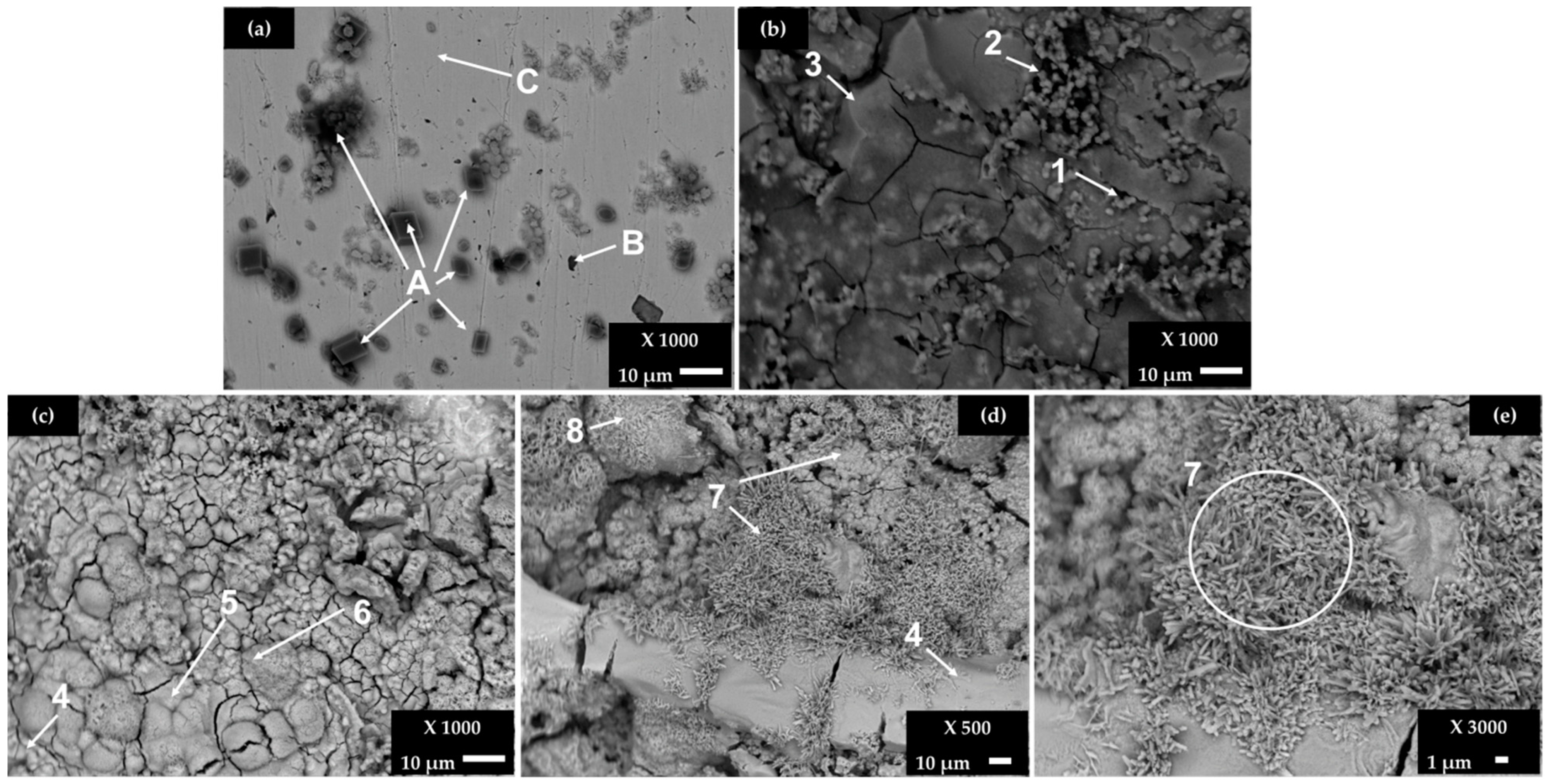
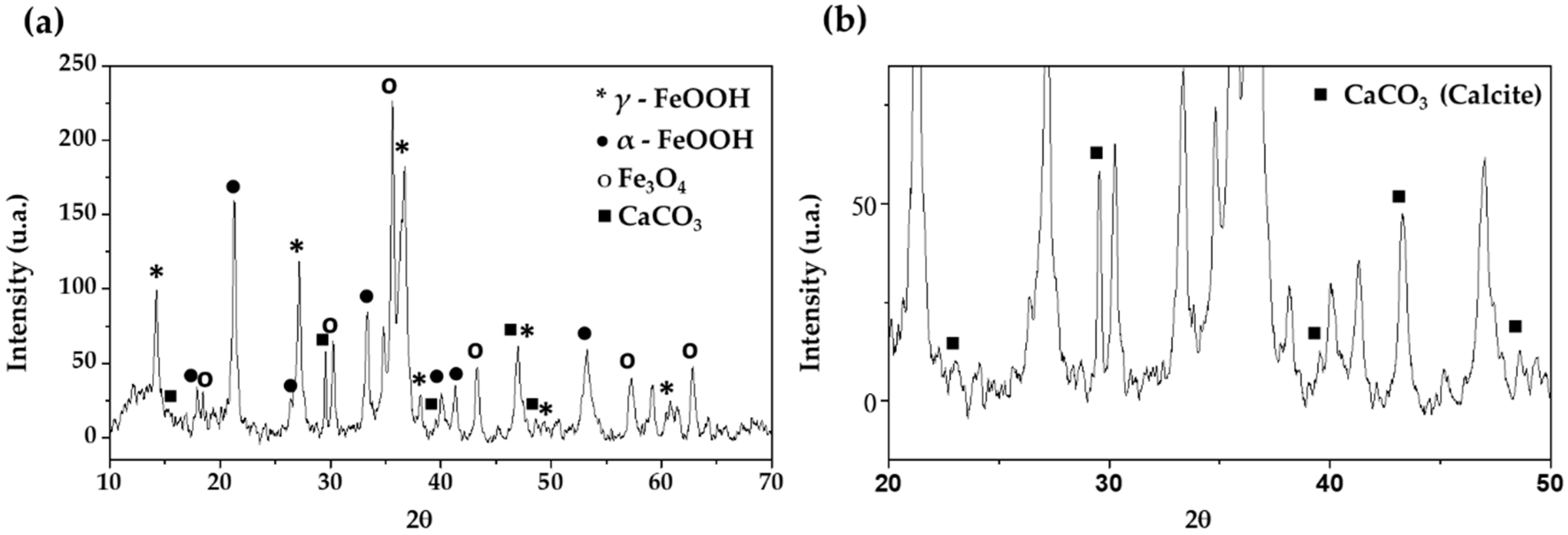
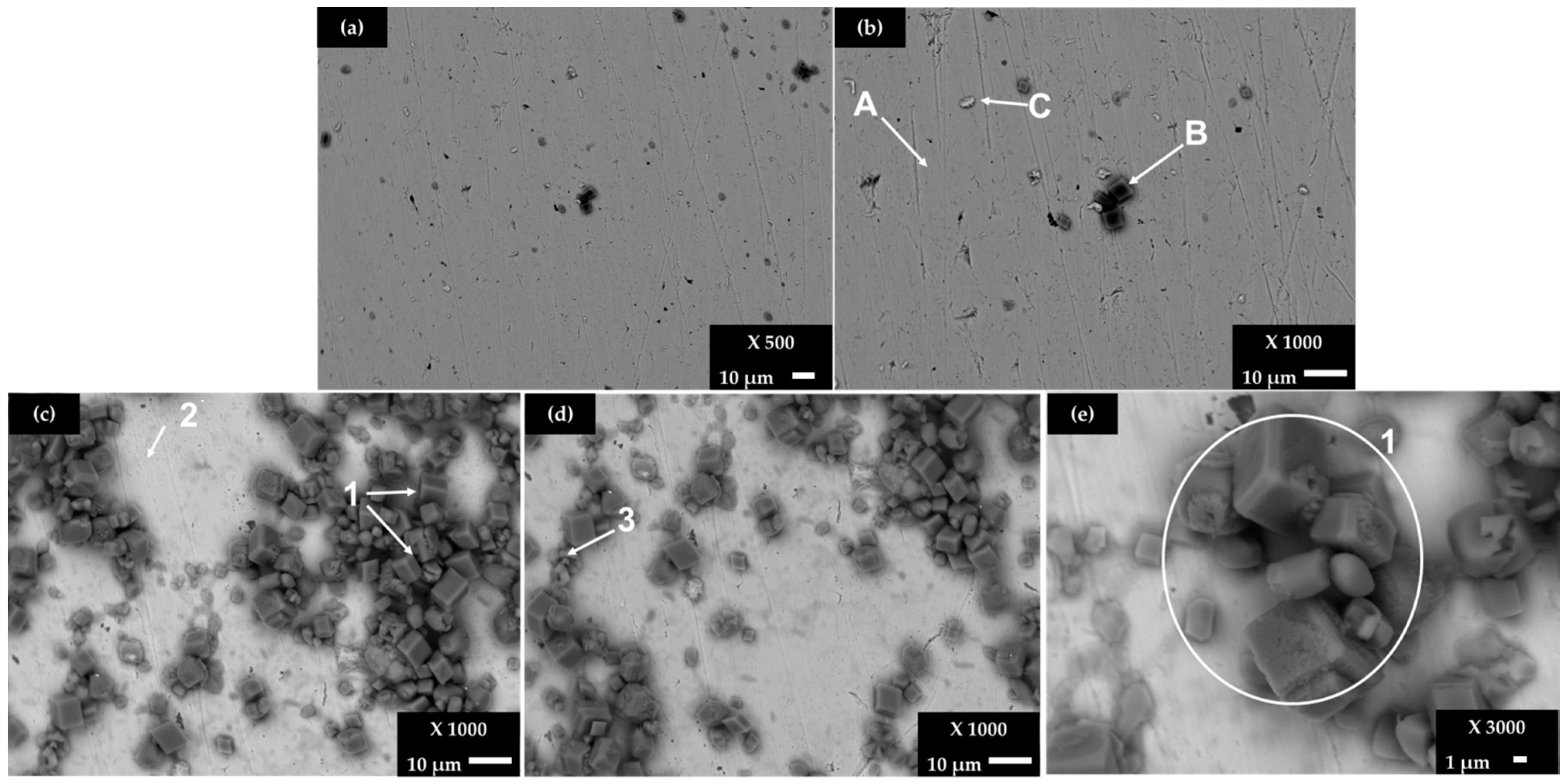
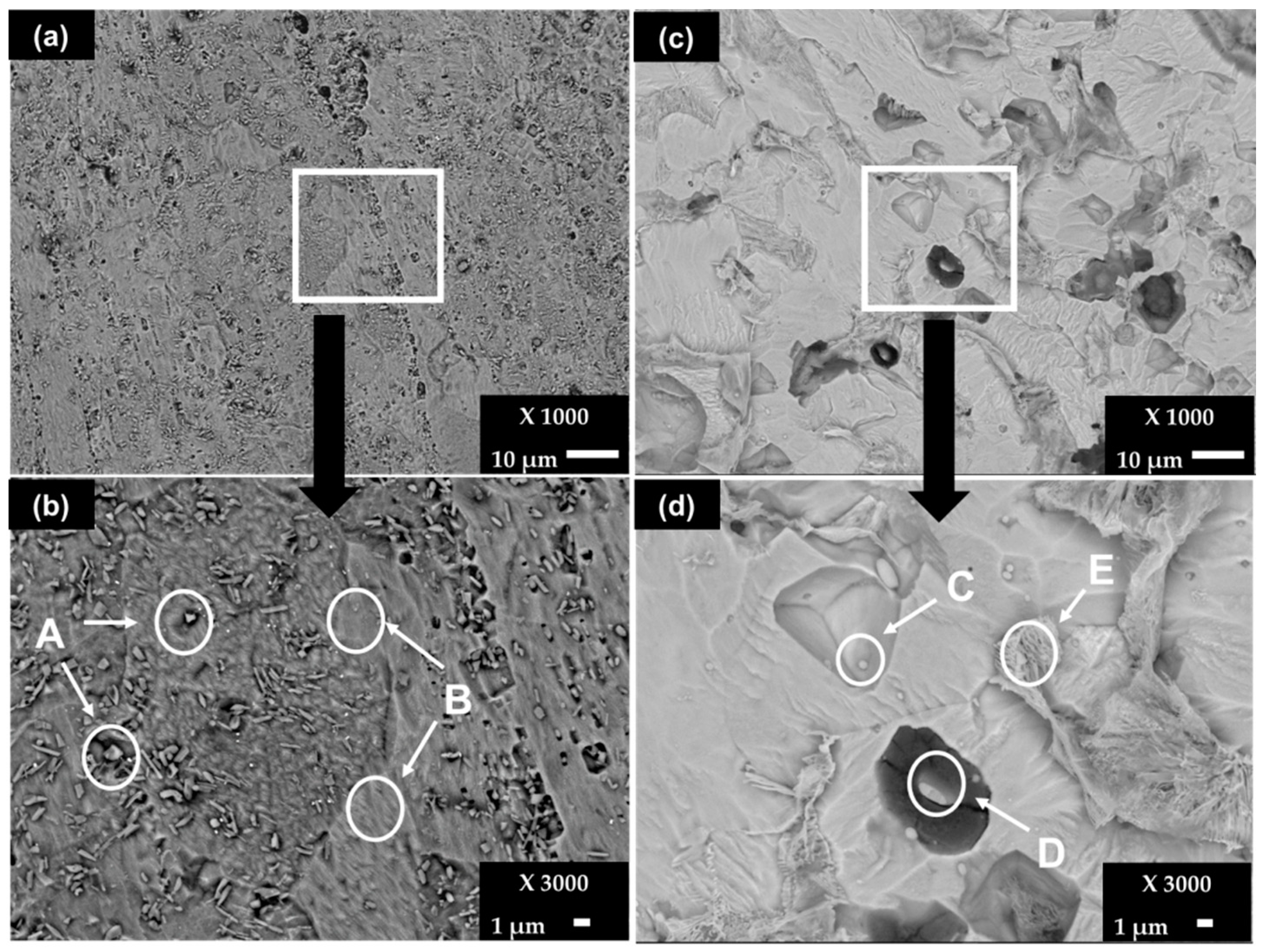
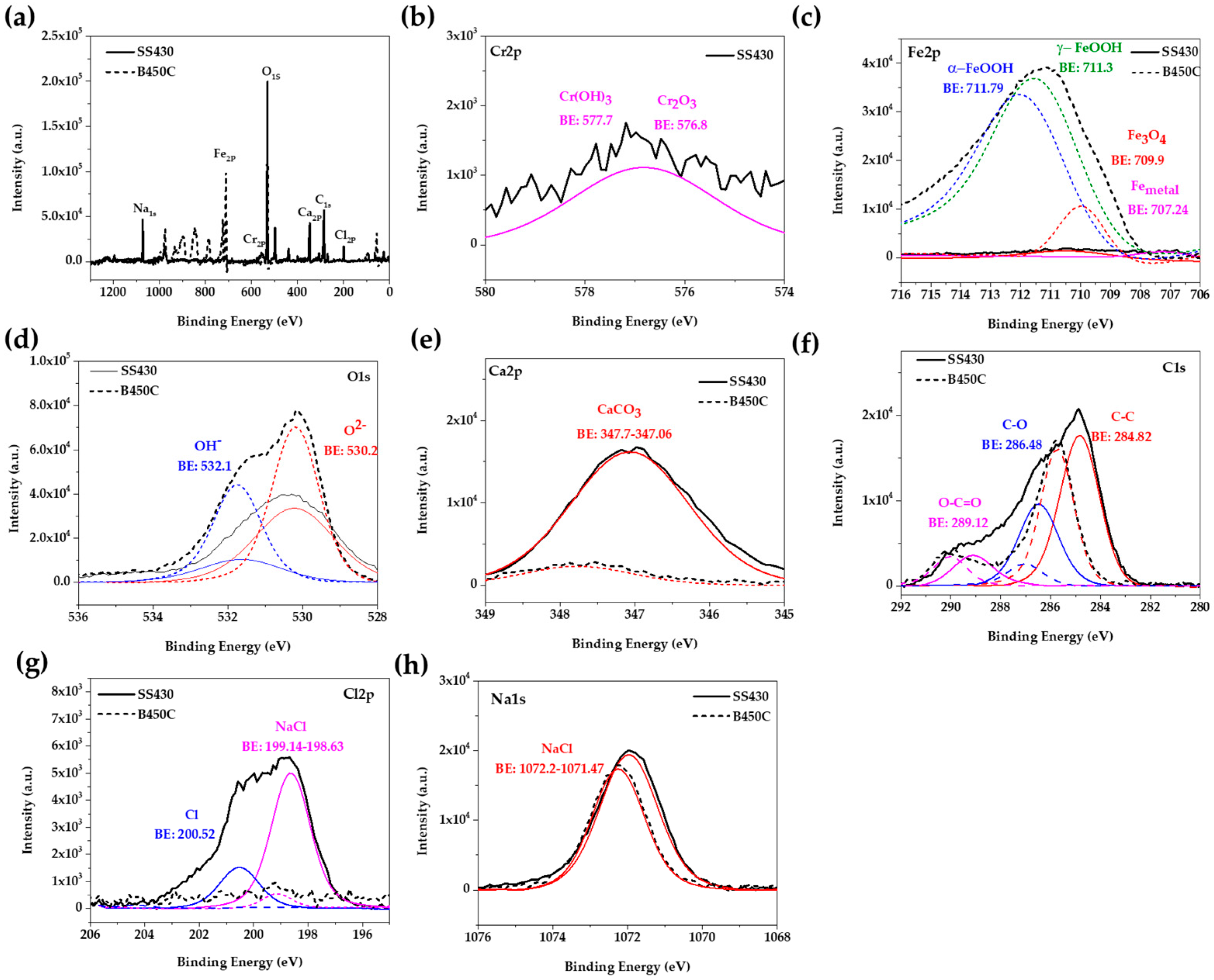
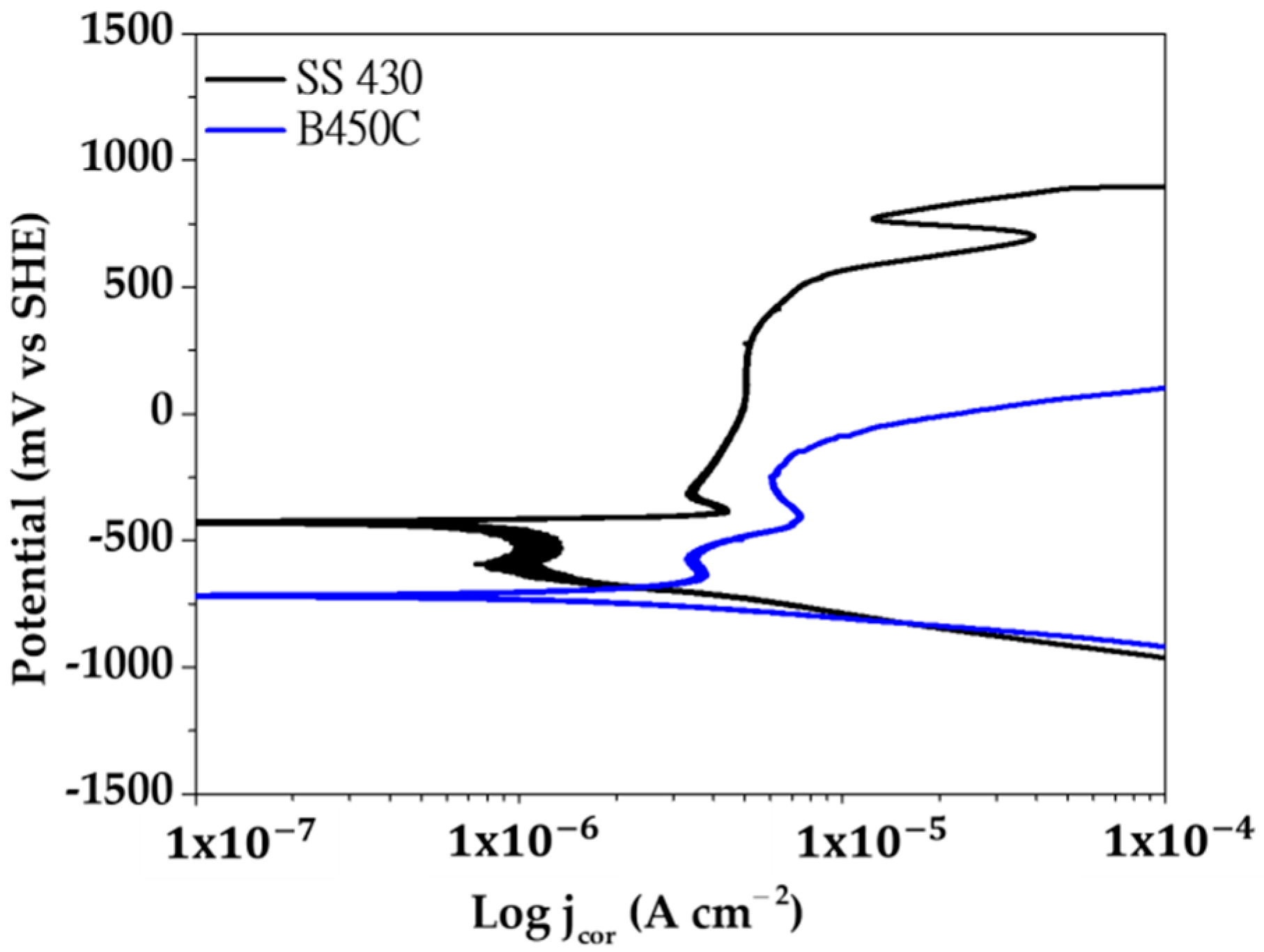
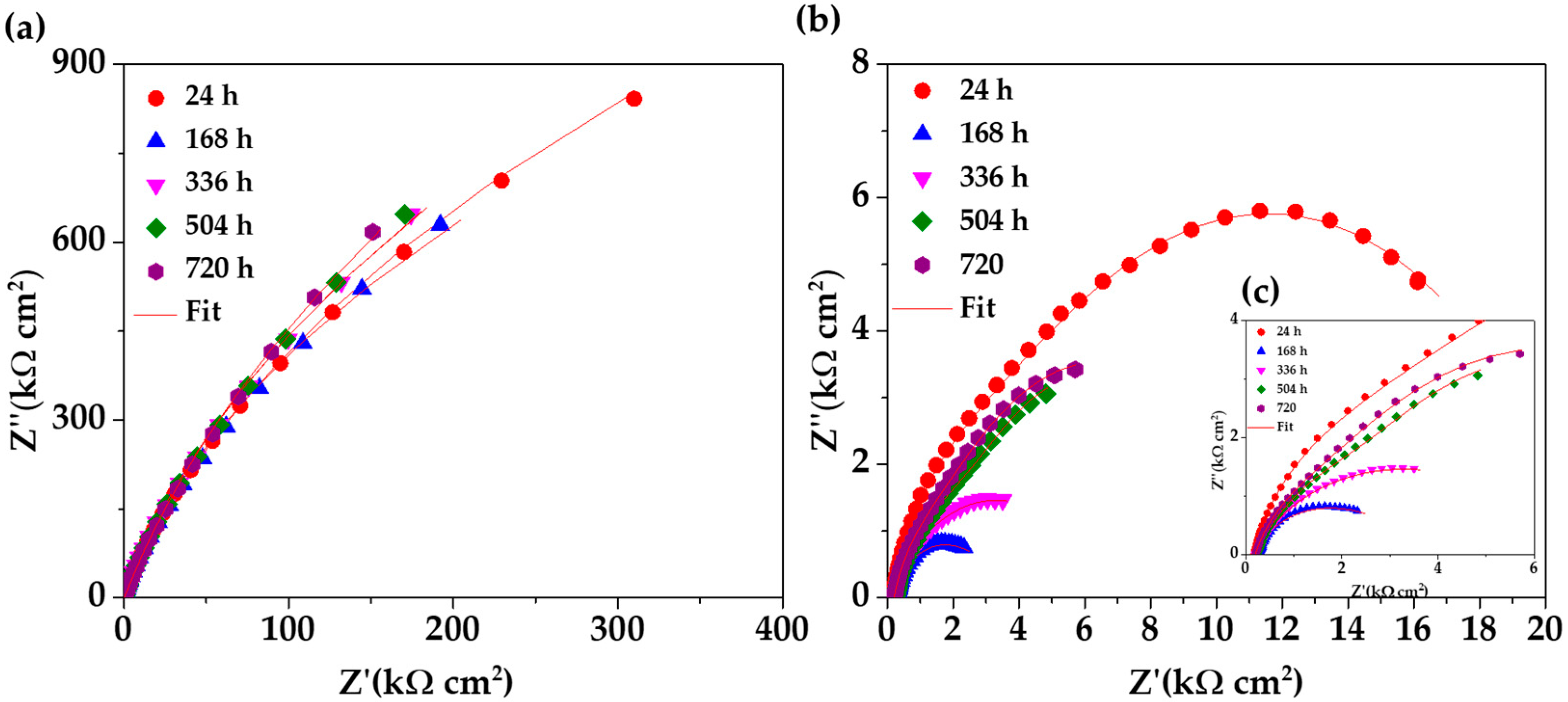
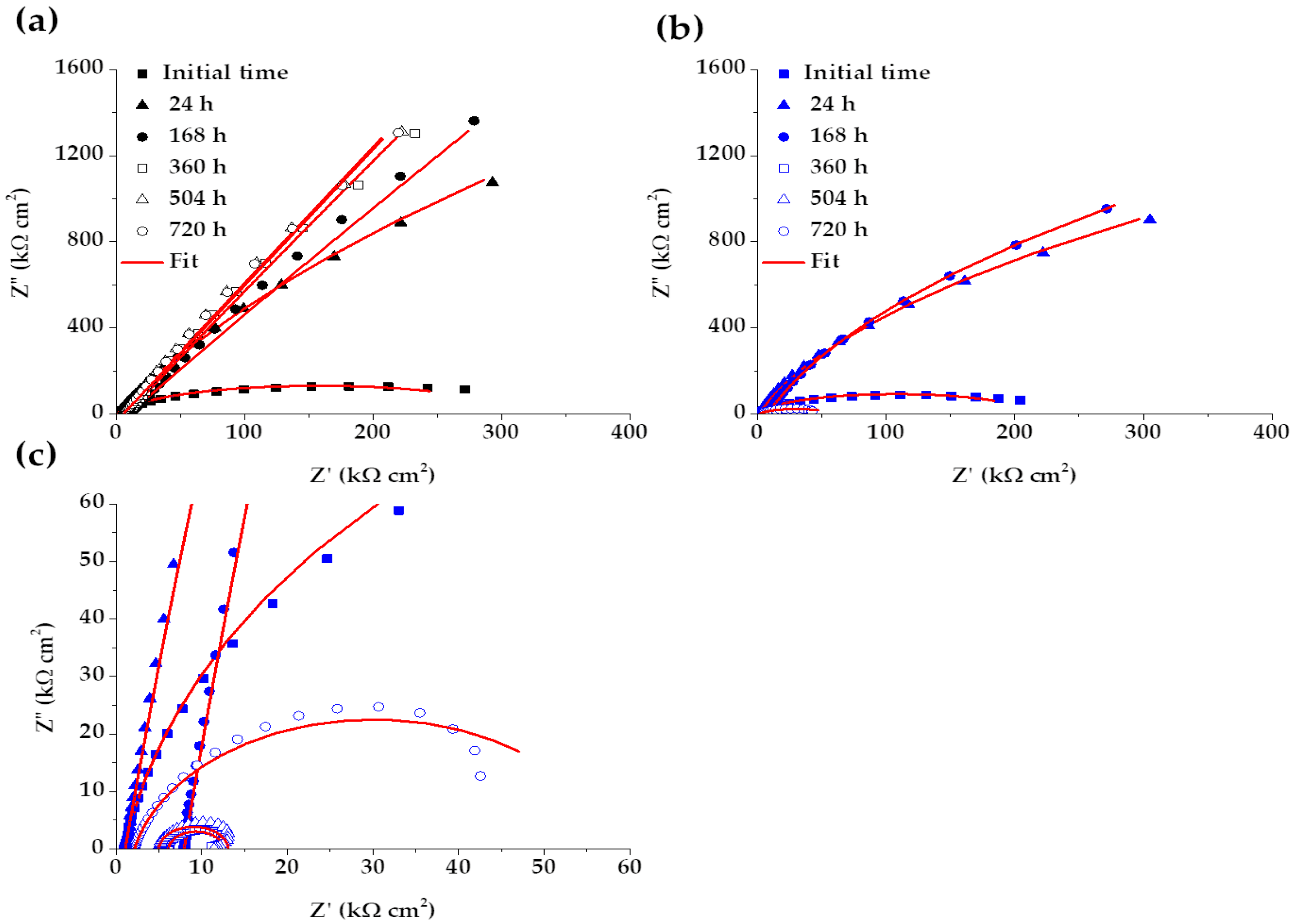

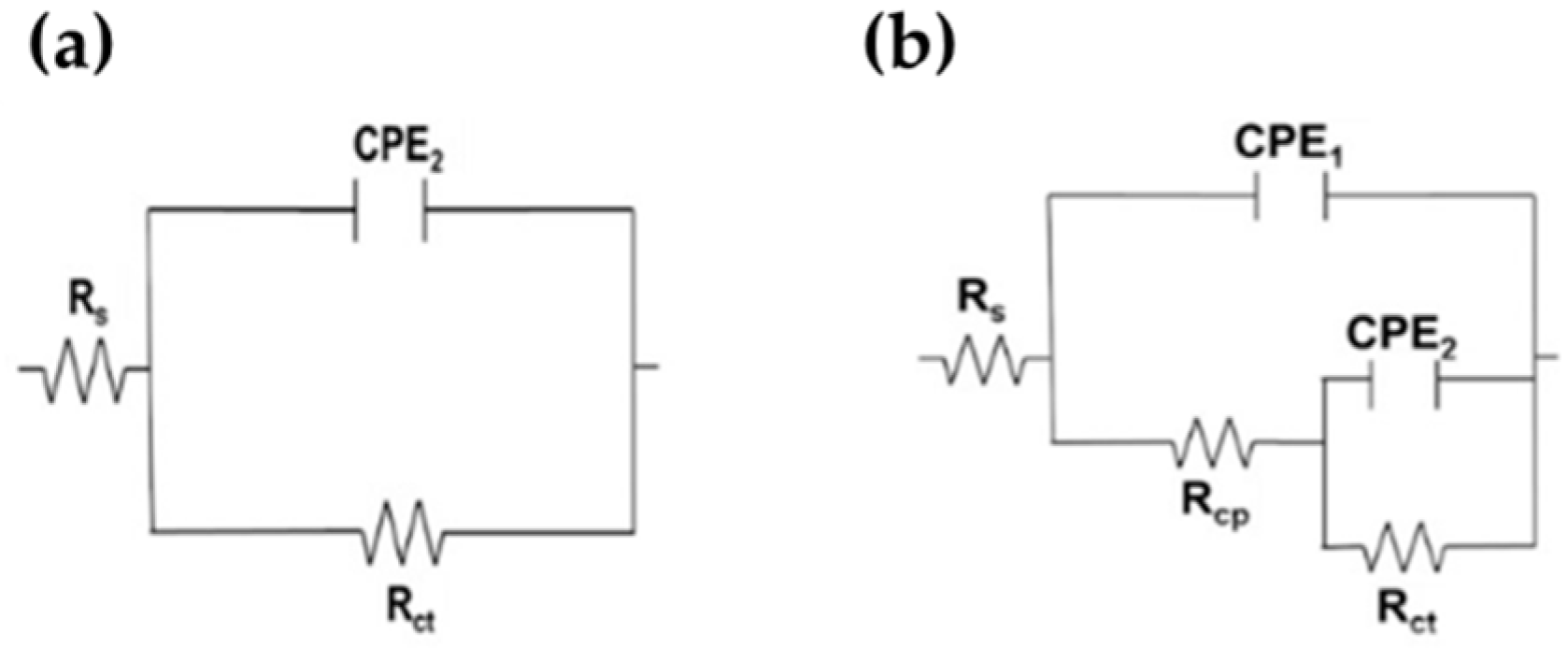

| Element (wt.%) | C | Cr | N | Cu | P | S | Fe |
|---|---|---|---|---|---|---|---|
| SS 430 | 0.05 | 16.2 | - | - | - | - | Balance |
| B450C | 0.22 | - | 0.12 | 0.8 | 0.5 | 0.5 | Balance |
| Element | Element | C | Cr | Mn | Si | O | V | Cu | N | S | Fe |
|---|---|---|---|---|---|---|---|---|---|---|---|
| SS 430 | General | 1.83 | 16.32 | 0.65 | 0.6 | 0.34 | 0.28 | - | - | - | 79.97 |
| A | 3.04 | 24.03 | - | 0.25 | 0.62 | 0.7 | - | 3.27 | - | 68.09 | |
| B | 17.19 | 9.21 | - | 28.86 | 1.35 | - | - | - | - | 43.39 | |
| B450C | General | 2.36 | - | 0.81 | - | 0.47 | - | - | - | - | 96.36 |
| C | 5.02 | - | 1.31 | 0.41 | 1.44 | - | 0.83 | - | 0.38 | 90.36 | |
| D | 8.49 | - | 0.73 | 6.46 | 0.46 | - | - | - | - | 83.85 |
| pH vs. Time (h) | Initial | 24 | 168 | 360 | 504 | 720 |
|---|---|---|---|---|---|---|
| SS 430 | 13.88 | 13.37 | 10.55 | 9.60 | 9.68 | 9.54 |
| B540C | 13.88 | 13.37 | 10.28 | 10.28 | 9.50 | 9.61 |
| Time (h) | Initial | 24 | 168 | 360 | 504 | 720 |
|---|---|---|---|---|---|---|
| SS 430 | −22.62 | −6.91 | 139.97 | 157.31 | 165.50 | 174.96 |
| B450C | −240.48 | −300.61 | −426.38 | −452.28 | −478.50 | −463.81 |
| Element | C | Mn | Si | O | Ca | Cu | Cl | Na | Fe | |
|---|---|---|---|---|---|---|---|---|---|---|
| B450C | A | 11.36 | - | - | 50.10 | 36.45 | - | - | 0.35 | 1.73 |
| B | 11.74 | 13.89 | 13.53 | 41.60 | 3.36 | - | - | 0.98 | 14.90 | |
| C | 2.73 | 0.80 | 0.34 | 2.02 | - | 1.58 | - | - | 92.53 | |
| 1 | 2.35 | 0.71 | 0.30 | 34.33 | - | 1.13 | - | - | 61.18 | |
| 2 | 3.47 | 1.37 | 0.31 | 37.93 | - | - | - | - | 56.92 | |
| 3 | 2.48 | 0.71 | 0.26 | 40.30 | - | - | - | - | 56.25 | |
| 4 | 2.47 | 0.51 | - | 37.12 | - | - | 0.32 | 0.70 | 58.88 | |
| 5 | 2.76 | - | - | 46.47 | - | - | 0.36 | - | 49.49 | |
| 6 | 3.13 | 0.52 | - | 38.19 | - | 1.50 | 0.32 | 0.96 | 55.38 | |
| 7 | 1.86 | - | - | 40.67 | - | - | 4.65 | - | 52.82 | |
| 8 | 3.59 | - | - | 46.78 | - | 1.09 | 2.91 | - | 45.63 |
| Element | C | Cr | Si | O | Ca | Cl | Na | Fe | |
|---|---|---|---|---|---|---|---|---|---|
| SS 430 | A | 2.27 | 6.25 | 0.49 | 1.18 | - | - | - | 79.81 |
| B | 14.81 | 0.63 | - | 53.66 | 28.78 | - | - | 2.12 | |
| C | 7.32 | 6.76 | 0.38 | 3.63 | - | - | - | 81.90 | |
| 1 | 15.87 | 1.41 | - | 47.24 | 27.02 | 2.21 | 0.95 | 5.31 | |
| 2 | 8.08 | 15.92 | 0.30 | 2.80 | 1.03 | 0.25 | - | 71.61 | |
| 3 | 24.68 | 1.06 | - | 9.99 | 1.87 | 41.10 | 17.64 | 3.65 |
| Element | C | Cr | Mn | O | V | Cu | N | S | Fe | |
|---|---|---|---|---|---|---|---|---|---|---|
| SS 430 | A | 8.44 | 42.36 | - | - | 2.94 | - | 12.61 | - | 33.64 |
| B | 2.46 | 16.46 | - | - | - | - | - | - | 81.04 | |
| B450C | C | 4.93 | - | 15.99 | 3.15 | - | 20.75 | - | 13.97 | 41.71 |
| D | 10.06 | - | 30.84 | 9.71 | - | 16.28 | - | 21.67 | 11.44 | |
| E | 12.68 | - | 1.35 | 5.13 | - | 1.34 | - | 0.55 | 78.96 |
| Steel | Time h | Rsol kΩcm2 | Rcp kΩcm2 | CPE1 μSsncm−2 | n1 | Rct kΩcm2 | CPE2 μSsncm−2 | n2 | Rp kΩcm2 | c2 10−4 |
|---|---|---|---|---|---|---|---|---|---|---|
| SS 430 | 24 | 0.23 | - | - | - | 5.3 × 103 | 16.47 | 0.91 | 5.3 × 103 | 6.04 |
| 168 | 0.23 | - | - | - | 4.3 × 103 | 23.09 | 0.92 | 4.3 × 103 | 10.78 | |
| 360 | 0.23 | - | - | - | 5.8 × 103 | 22.94 | 0.92 | 5.8 × 103 | 7.20 | |
| 504 | 0.22 | - | - | - | 5.7 × 103 | 22.73 | 0.92 | 5.7 × 103 | 2.03 | |
| 720 | 0.24 | - | - | - | 7.3 × 103 | 23.80 | 0.91 | 7.3 × 103 | 5.28 | |
| B450C | 24 | 0.21 | 6.41 | 56.80 | 0.85 | 20.11 | 191.01 | 0.65 | 2.65 × 10 | 1.37 |
| 168 | 0.23 | 0.29 | 703.25 | 0.46 | 4.24 | 315.88 | 0.96 | 4.53 | 5.21 | |
| 336 | 0.24 | 0.18 | 592.50 | 0.46 | 8.33 | 268.62 | 0.91 | 8.51 | 2.63 | |
| 504 | 0.27 | 6.50 | 625.87 | 0.48 | 7.21 | 2.7 × 103 | 0.90 | 1.37 × 10 | 6.69 | |
| 720 | 0.25 | 4.48 | 511.25 | 0.78 | 9.87 | 1.1 × 103 | 0.75 | 1.43 × 10 | 1.31 |
Publisher’s Note: MDPI stays neutral with regard to jurisdictional claims in published maps and institutional affiliations. |
© 2022 by the authors. Licensee MDPI, Basel, Switzerland. This article is an open access article distributed under the terms and conditions of the Creative Commons Attribution (CC BY) license (https://creativecommons.org/licenses/by/4.0/).
Share and Cite
Veleva, L.; Bonfil, D.; Bacelis, Á.; Feliu, S., Jr.; Cabrini, M.; Lorenzi, S. Corrosion Activity of Carbon Steel B450C and Low Chromium Ferritic Stainless Steel 430 in Chloride-Containing Cement Extract Solution. Metals 2022, 12, 150. https://doi.org/10.3390/met12010150
Veleva L, Bonfil D, Bacelis Á, Feliu S Jr., Cabrini M, Lorenzi S. Corrosion Activity of Carbon Steel B450C and Low Chromium Ferritic Stainless Steel 430 in Chloride-Containing Cement Extract Solution. Metals. 2022; 12(1):150. https://doi.org/10.3390/met12010150
Chicago/Turabian StyleVeleva, Lucien, David Bonfil, Ángel Bacelis, Sebastian Feliu, Jr., Marina Cabrini, and Sergio Lorenzi. 2022. "Corrosion Activity of Carbon Steel B450C and Low Chromium Ferritic Stainless Steel 430 in Chloride-Containing Cement Extract Solution" Metals 12, no. 1: 150. https://doi.org/10.3390/met12010150
APA StyleVeleva, L., Bonfil, D., Bacelis, Á., Feliu, S., Jr., Cabrini, M., & Lorenzi, S. (2022). Corrosion Activity of Carbon Steel B450C and Low Chromium Ferritic Stainless Steel 430 in Chloride-Containing Cement Extract Solution. Metals, 12(1), 150. https://doi.org/10.3390/met12010150










